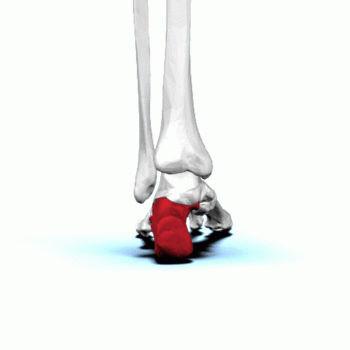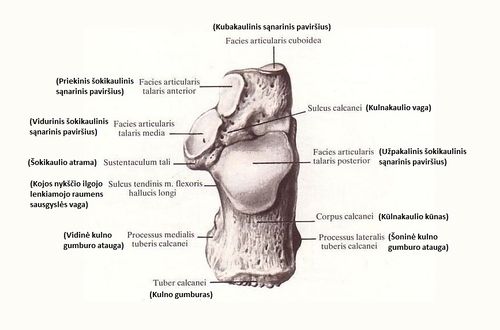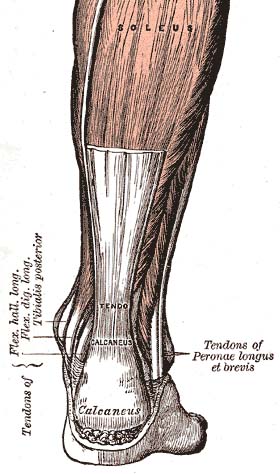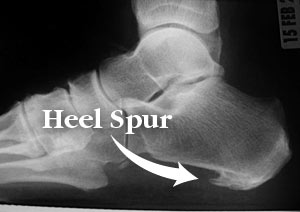Calcaneus: Difference between revisions
No edit summary |
No edit summary |
||
| Line 1: | Line 1: | ||
<div class="editorbox"> '''Original Editor '''- [[User:User Name|User Name]] '''Top Contributors''' - {{Special:Contributors/{{FULLPAGENAME}}}}</div> | <div class="editorbox"> '''Original Editor '''- [[User:User Name|User Name]] '''Top Contributors''' - {{Special:Contributors/{{FULLPAGENAME}}}}</div> | ||
<div class="editorbox"> | <div class="editorbox"> | ||
| Line 39: | Line 37: | ||
== Articulations == | == Articulations == | ||
* Superiorly, the calcaneus articulates with the talus at the talocalcaneal joint, (subtalar joint), making contact at anterior, middle and posterior facets. | |||
* The anterior part of the talocalcaneal joint and the talonavicular joint are collectively known as the talocalcaneonavicular joint, and may share the same joint space. | |||
* Anteriorly, the calcaneus articulates with the cuboid (calcaneocuboid joint) bones.<ref name=":1" /> | |||
=== Attachments === | === Attachments === | ||
'''Muscular''' | '''Muscular''' | ||
* triceps surae, i.e. gastrocnemius and soleus (insertion: middle facet of posterior surface of calcaneus through calcaneal/Achilles tendon) | *[[File:Achilles tendon.jpg|right|frameless|474x474px]]triceps surae, i.e. gastrocnemius and soleus (insertion: middle facet of posterior surface of calcaneus through calcaneal/Achilles tendon) | ||
* abductor hallucis (origin: the medial process of calcaneal tuberosity) | * abductor hallucis (origin: the medial process of calcaneal tuberosity) | ||
* flexor digitorum brevis (origin: the medial process of calcaneal tuberosity and plantar aponeurosis) | * flexor digitorum brevis (origin: the medial process of calcaneal tuberosity and plantar aponeurosis) | ||
| Line 60: | Line 61: | ||
== Related Pathology == | == Related Pathology == | ||
* [[Calcaneal Fractures|calcaneal fracture]] | *[[File:Heel-spur.jpg|right|frameless]][[Calcaneal Fractures|calcaneal fracture]] | ||
* pseudotumour of the calcaneus | * pseudotumour of the calcaneus | ||
* talocalcaneal coalition | * talocalcaneal coalition | ||
| Line 68: | Line 69: | ||
* A [[Haglund's deformity|Haglund]] deformity is a bony exostosis that extends from the posterior superior calcaneus where the Achilles attaches. The etiology of the condition is unknown but hypothesized causes are Achilles tendonitis, high arched feet, improper footwear, and other hereditary factors.<ref name=":0" /> | * A [[Haglund's deformity|Haglund]] deformity is a bony exostosis that extends from the posterior superior calcaneus where the Achilles attaches. The etiology of the condition is unknown but hypothesized causes are Achilles tendonitis, high arched feet, improper footwear, and other hereditary factors.<ref name=":0" /> | ||
== | == References == | ||
<references /> | <references /> | ||
| Line 80: | Line 75: | ||
[[Category:Anatomy]] | [[Category:Anatomy]] | ||
[[Category:Bones]] | [[Category:Bones]] | ||
[[Category:Bone - Conditions]] | |||
Revision as of 08:19, 12 March 2020
Original Editor
Top Contributors - Abbey Wright, Lucinda hampton, Kim Jackson, Leana Louw and Manisha Shrestha
Introduction[edit | edit source]
The calcaneus bone is one of the 7 articulating bones that make up the tarsus. The calcaneus is located in the hindfoot with the talus and is the largest bone of the foot.
- It is commonly referred to as the heel.
- Numerous ligaments and muscles attach to the calcaneus and help with its role in human bipedal biomechanics[1]
- It articulates with the talus superiorly and the cuboid anteriorly and shares a joint space with the talonavicular joint, appropriately called the talocalcaneonavicular joint.
- The calcaneus transfers most of the body weight from the lower limb to the ground.[2]
Structure[edit | edit source]
The calcaneus is an irregular, roughly box-shaped bone sitting below the talus. Its long axis is orientated along the mid-line of the foot, however deviates lateral to the mid-line anteriorly. It projects posteriorly to form the core of the heel.
The posterior part of the calcaneus is circular, with three facets (superior, middle and inferior).
- The superior facet is separated from the calcaneal tendon by the retrocalcaneal bursa.
- The middle facet provides the attachment site for the calcaneal tendon (Achilles tendon).
- The inferior facet curves anteriorly and is continuous with calcaneal tuberosity on the plantar surface.
The plantar surface of the calcaneal tuberosity projects forward on the plantar surface as a medial (larger) and lateral (smaller) process and at its most anterior projection is the calcaneal tubercle, where the short plantar ligament attaches.
On the lateral aspect of the calcaneus is the peroneal tubercle, anterior to the middle of the surface, where the tendons of the fibularis brevis and longus muscles pass above and below respectively.
Protruding anteromedially from upper margin of the medial surface is the sustentaculum tali which supports the more posterior part of the head of the talus.
At its inferior aspect is a groove accommodating the flexor hallucis longus tendon.
Superiorly is the middle talar articular facet for the corresponding middle facet of the head of talus as part of the subtalar joint.
The anterior and posterior facets of the talocalcaneal joint are on the superior surface of the calcaneus. The anterior facet is small and the posterior facet is large. Between these two facets runs a fairly deep sulcus, the calcaneal sulcus, which together with the opposing talar sulcus forms the tarsal sinus.
The anterior surface has a convex articular facet for the cuboid bone[2].
Articulations[edit | edit source]
- Superiorly, the calcaneus articulates with the talus at the talocalcaneal joint, (subtalar joint), making contact at anterior, middle and posterior facets.
- The anterior part of the talocalcaneal joint and the talonavicular joint are collectively known as the talocalcaneonavicular joint, and may share the same joint space.
- Anteriorly, the calcaneus articulates with the cuboid (calcaneocuboid joint) bones.[2]
Attachments[edit | edit source]
Muscular
- triceps surae, i.e. gastrocnemius and soleus (insertion: middle facet of posterior surface of calcaneus through calcaneal/Achilles tendon)
- abductor hallucis (origin: the medial process of calcaneal tuberosity)
- flexor digitorum brevis (origin: the medial process of calcaneal tuberosity and plantar aponeurosis)
- quadratus plantae (origin: the plantar surface of calcaneus)
- abductor digiti minimi (origin: the medial and lateral process of calcaneal tuberosity)
- extensor digitorum brevis (origin: dorsolateral surface)
- extensor hallucis brevis (origin: dorsal surface, tarsal sinus)
Ligamentous
- lateral: lateral collateral ligament of the ankle joint (calcaneofibular ligament)
- inferior: short plantar ligament (at calcaneal tubercle), long plantar ligament (in front of calcaneal tuberosity), plantar aponeurosis (medial process of calcaneal tuberosity proximal to flexor digitorum brevis)
- superior: tarsal sinus ligaments, including:
- cervical ligament
- talocalcaneal interosseous ligament,
- lateral, intermediate, and medial roots of the inferior extensor retinaculum
- bifurcate ligament
- anterior: plantar calcaneonavicular ligament (anterior margin of the sustentaculum tali of the calcaneus)[2]
Related Pathology[edit | edit source]
- calcaneal fracture
- pseudotumour of the calcaneus
- talocalcaneal coalition
- calcaneonavicular coalition
- calcaneal spur[2]
- Plantar fasciitis (is a very prevalent condition that involves a noninflammatory structural breakdown of the connective tissue that makes up the plantar aponeurosis or fascia of the foot). Often found in association with heel spurs.[1]
- A Haglund deformity is a bony exostosis that extends from the posterior superior calcaneus where the Achilles attaches. The etiology of the condition is unknown but hypothesized causes are Achilles tendonitis, high arched feet, improper footwear, and other hereditary factors.[1]
References[edit | edit source]
- ↑ 1.0 1.1 1.2 Gupton M, Terreberry RR. Anatomy, bony pelvis and lower limb, calacaneous. InStatPearls [Internet] 2018 Dec 6. StatPearls Publishing. Available from:https://www.statpearls.com/kb/viewarticle/18764 (last accessed 12.3.2020)
- ↑ 2.0 2.1 2.2 2.3 2.4 Calcaneus Radiopedia Available from:https://radiopaedia.org/articles/calcaneus?lang=gb (last accessed 12.3.2020)










